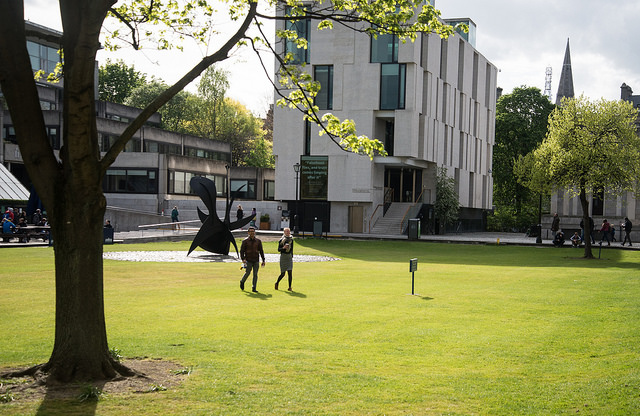
While thousands of women spent the evening of International Women’s Day marching for repeal, many others, young and old, packed themselves into Trinity’s Long Room Hub to hear an inspiring lecture by Dr Susan Cahill entitled “Bold Girls: A Literary History of Wild Irish Girls”.
The audience hosted trailblazing contemporary Irish authors Sheena Wilkinson and Marian Keyes, and many attendees brought along their young daughters to celebrate girlhood in all its glory. Cahill began by remarking that it was “great to see a few repeal jumpers in the audience”. Along with being an accomplished academic, currently researching at the School of Irish Studies in Concordia University, she is also heavily involved in activism as part of the pro-choice campaign. She became the first woman to give a first-hand account of abortion on the Abbey Stage in 2016, and her passion for women’s rights and representation extends into every facet of her work.
Cahill used Lisa McGee’s Derry Girls as a starting point for her discussion, as “the girls in this are boisterous” and “unashamedly bawdy”. Describing the series as “almost unique” in its portrayal of “sweary but sweet” Irish girls, she mapped similarities between them and the “bold girls” she researches in late 19th and early 20th century Irish books for young readers. She is currently writing a book on her research and is fascinated by this period that she describes as a “really potent time for the Irish adolescent girl”.
Her discussion centred around Catherine Tynan and Rosa Mulholland, authors that the prolific girls’ stories writer LT Meade praised as the “champion of girls” and “queen of girls’ book-makers”, and explored their female protagonists. “They’re rebellious, they’re expressive, they take up space”, and yet the “Irish literary canon fails to take account of them”.
The discussion drew both gasps and laughter from the audience as Cahill recounted the sexism and belittlement faced by these authors. Meade is evidently a particular favourite for Cahill, as she pointed out that she was “as famous to her audience as JK Rowling”. “[Meade] invented some genres, such as the medical mystery”, wrote in the same periodicals in which Sherlock Holmes was first serialised and was “extraordinarily prolific”, writing about 12 novels a year, Cahill asserted.
Cahill concluded by addressing the “broader feminist and activist energy” prevalent in post-recession Ireland and how it has led to the rise of Irish young adult fiction. She praises authors of the genre including Claire Hennessy, Sarah Crossan, Louise O’Neill, Sheena Wilkinson, Deirdre Sullivan, Sarah Maria Griffin and Sinéad O’Hart, all of whom are strong female authors writing about girls. She finished on a “note of magic”, telling attendees to go and seek out the “spell books of the lost and found” which prioritise “a taking seriously of the teenage girls’ consciousness”.
The lecture was followed by the official opening of Story Spinners: Irish Women and Children’s Books, an exhibition in Trinity’s Long Room in the Old Library. This will run from March until May, and it was curated by Dr Jane Suzanne Carroll, Dr Pádraic Whyte and their students on the MPhil in Children’s Literature course in Trinity’s School of English. The project was funded by the Trinity Equality Fund.
Speaking to The University Times by email, Whyte noted that “the exhibition has really come together because of the hard work and enthusiasm of the students … It’s great to see students getting access to and getting excited about the rich resources in the Library. In such a significant year [marking the centenary of women’s suffrage], it’s important to celebrate and highlight the significance of Irish women’s writing and illustration for children, and to offer a glimpse into the diversity of female experiences depicted in literature for boy and girl readers across several centuries”.
Carroll added to this by highlighting the exhibition’s achievement in drawing “fresh attention to the role children’s literature plays – and has played for hundreds of years – in empowering readers and equalising representation of women”. It features a spread of books from Trinity’s newly catalogued Pollard Collection of children’s books, ranging from contemporary novels such as Siobhan Dowd’s A Swift Pure Cry to works by iconic 19th-century authors being studied by Cahill, including LT Meade, Maria Edgeworth, Patricia Lynch and a book illustrated by Maude Gonne. Supplemental materials on the exhibition will also be made available on the library’s website.
Trinity’s events coincided with the launch of the much larger nationwide “Bold Girls” initiative by Children’s Books Ireland. Dr Norah Patten, a faculty member at the International Space University who is on course to become Ireland’s first person in space, officially launched the initiative. She stressed that the “representation and visibility of strong, brave, intelligent women and girls is equally as important for young boys as it is for young girls. If we strive for an inclusive society, we need to think about the messages we are sending to boys and girls, young and old”.
CBI has produced a reading guide as a resource for schools and parents, showcasing contemporary Irish female authors and their books, which feature female protagonists. The hope is of gaining increased awareness and representation for gender equality in children’s literature. The main lesson? Bold girls are a force for change.






